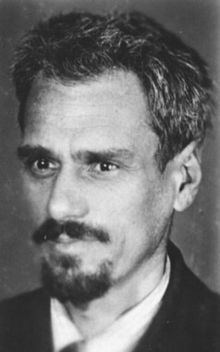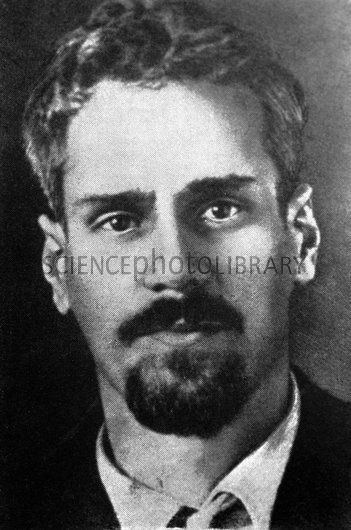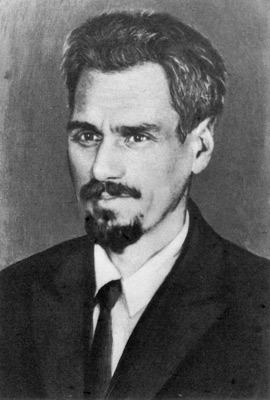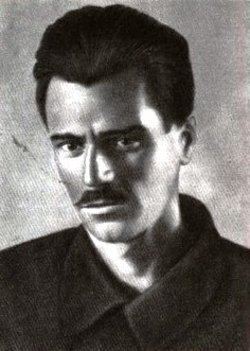Cause of death Missing in action Nationality Ukrainian Name Yuri Kondratyuk | Alma mater self-educated Role Engineer | |
 | ||
Full Name Oleksandr Hnatovych Shargei Education Peter the Great St. Petersburg Polytechnic University Parents Ignatiy Benediktovich Shargei, Ludmila Lvovna Schlippenbach | ||
Years of service 1916-1918, 1941–1942 | ||
Yuriy Vasilievich Kondratyuk (real name Aleksandr Ignatyevich Shargei, Ukrainian: Олександр Гнатович Шаргей, Oleksandr Hnatovych Sharhei) (June 21, 1897 – February 1942) was a Soviet engineer and mathematician. He was a pioneer of astronautics and spaceflight, a theoretician and a visionary who, in the early 20th century, developed the first known lunar orbit rendezvous (LOR), a key concept for landing and return spaceflight from Earth to the Moon. The LOR was later used for the plotting of the first actual human spaceflight to the Moon. Many other aspects of spaceflight and space exploration are covered in his works.
Contents
- Early life
- Higher education and World War I
- First Soviet years
- First book engineering work and imprisonment
- Post imprisonment research on wind power
- World War II fighting and death
- Selected works
- Remembrance and tributes
- References

Kondratyuk made his scientific discoveries in circumstances of war, repetitious persecutions from authorities and serious illnesses.

"Yuriy Kondratyuk" is a stolen identity under which the author was hiding after the Russian revolution and became known to the scientific community.

Early life

Kondratyuk was born as Aleksandr Ignatyevich Shargei in 1897 in Poltava, Russian Empire (now Ukraine) although his family originally lived in Kiev. His father, Ignat Benediktovich Shargei, studied physics and mathematics in Kyiv University at the time of his marriage. Kondratyuk's mother, Ludmila Lvovna Schlippenbach taught French at a Kiev school, and must have already been pregnant when she married in January 1897. She is a direct descendant of Wolmar Anton von Schlippenbach, a general who took part in Charles XII of Sweden's failed invasion of Russia. Her grandfather Anton von Schlippenbach was Lt. Colonel of Russian army and participated in the Napoleonic wars. Ludmyla was devoted to social activism and was imprisoned on several occasions for participating in demonstrations. During her last stay in a Kiev prison, shortly before Aleksandr was born, she was diagnosed with a mental disorder and placed into an asylum in 1902. Aleksandr lived with his father and step-mother in St. Petersburg until 1910, when his father died and Aleksandr returned to Poltava to live with his paternal grandmother.

From an early age, Kondratyuk was fascinated by his father's books on physics and mathematics and demonstrated great abilities in these areas. When he was old enough to attend high school, he was admitted straight into the third form of a prestigious high school, where he graduated with a gold medal for proficiency a few years later.
Higher education and World War I

Kondratyuk later enrolled at the Great Polytechnic in Petrograd to study engineering, where he was influenced by Ivan Meshcherskiy. Soon he was drafted into the army at the outbreak of World War I and graduated from warrant officer school there. During his military service on the Caucasian Front, Kondratyuk filled four notebooks with his ideas of interplanetary flight. These included suggesting the use of a modular spacecraft to reach the Moon, leaving the propulsion section of the vehicle on orbit while a smaller lander journeyed to the surface and back (the strategy eventually adopted by the engineers of the Apollo program). He included detailed calculations of the trajectory to take a spacecraft from Earth orbit to lunar orbit and back to Earth orbit, a trajectory now known as "Kondratyuk's route" or "Kondratyuk's loop".
First Soviet years
Kondratyuk left the army in 1917 following the Russian Revolution and tried to make a living stoking boilers back in Poltava. As a locally born former officer of the Tsarist army, he was at high risk of arrest by Bolshevik authorities as an enemy of the people. The following year, Kondratyuk made an attempt to escape for Poland but was stopped and turned back by border guards. Ordinarily, he would probably have been shot, but the guards recognised the early symptoms of typhus in him and perhaps decided to spare themselves a bullet. He was nursed back to health by a neighbour, and on the advice of friends, decided to flee for another location. His friends obtained forged identification papers for him, with the name of Yuri Vasilievich Kondratyuk, born in Lutsk in 1900 (who in reality had died of tuberculosis in 1921). With this new identity, Kondratyuk lived in southern Ukraine, Kuban and Northern Caucasus, working as a mechanic and railroad worker. He settled in Novosibirsk in Siberia in 1927.
First book, engineering work and imprisonment
Working as a mechanic, Kondratyuk completed the manuscript of a book titled Conquest of Interplanetary Space, dealing with rocket motion and issues concerning the colonization of space. He also suggested using a gravitational slingshot trajectory to accelerate a spacecraft. In 1925, Kondratyuk made contact with Moscow-based scientist Vladimir Vetchinkin and sent him the manuscript. Up to that time, he and his work were unknown to rocketry enthusiasts. While the book was enthusiastically received by scientists in Moscow, no publisher would touch such a fanciful work. Eventually, Kondratyuk paid a Novosibirsk printing shop to produce 2,000 copies of the 72-page work, and even then had to do much of the typesetting and operating the press himself, both to save costs but also because the equations in the book posed problems for the printer. Kondratyuk's discoveries were made independently of Konstantin Tsiolkovsky who also worked on spaceflight issues at that time; the two never met.
Applying his engineering skill to local problems, Kondratyuk designed a huge 13,000 ton grain elevator (quickly nicknamed "Mastodon") in Kamen-na-Obi, built of wood without a single nail since metal was in short supply in Siberia. This ingenuity would work against him when in 1930 he was investigated as a "saboteur" by the NKVD. The lack of nails in the structure was used as evidence that he had planned it to collapse. Convicted of anti-Soviet activity, Kondratyuk was sentenced to three years in GULAG, but because of his evident talents was sent to a sharashka (research facility prison) rather than a labour camp. There, he was first put to work evaluating foreign coal mining machinery for the use in Kuzbass, and quickly impressed the camp supervisor with his ingenuity. At the supervisor's request, in November 1931 a review board changed Kondratyuk's status from "prisoner" to "exiled", and sent him to work on Siberian grain projects.
Post-imprisonment research on wind power
Kondratyuk learned of a competition to design a large wind power generator for the Crimea, sponsored by Sergo Ordzhonikidze, then People's Commissar for Heavy Industry. With fellow exiled engineers Pyotr Gorchakov and Nikolai Nikitin, Kondratyuk submitted a design for a 165 metre (500 ft) high concrete tower supporting a four-bladed propeller with a span of 80 metres (240 ft) and capable of generating up to 12,000 kW. In November 1932, Ordzhonikidze selected this design as the winner and invited the team to meet with him in Moscow before sending them to Kharkiv to finalise the design and supervise its construction. While in Moscow, Kondratyuk had the opportunity to meet Sergei Korolev, then head of the GIRD (Soviet rocket research group). Korolev offered Kondratyuk a position on his staff, but Kondratyuk declined, fearing that the scrutiny he would come under the NKVD would reveal his true identity.
Kondratyuk, Gorchakov, and Nikitin worked on the wind power project for the next four years until Ordzhonikidze's mysterious death in 1937. Overnight, the project was deemed to be too expensive and dangerous and was shut down, the tower only half-built. Nikitin would later use what he had learned on this project when he designed the Ostankino Tower in the 1960s. Meanwhile, the men went to work on designing smaller wind turbines (in the 150-200 kW range) to power farms. During this time, Kondratyuk learned of the arrest of Korolev on charges of treason for wasting time on designing spacecraft. He immediately decided to divest himself of his own copious notes on the subject. The former neighbour in Novosibirsk who had nursed him back to health after his episode of typhus agreed to take his notebooks and eventually took these to the United States when she escaped there with her daughter following World War II. He also sent a copy of his published work to the Tsiolkovsky museum in Kaluga.
World War II fighting and death
Kondratyuk joined the Red Army as a volunteer in June 1941 and died in 1942 near Kaluga. The exact circumstances of his death are not known. His unit was involved in heavy fighting against the Nazis in October 1941, and October 3 is sometimes given as the date of his demise. Evidence collected in the 1990s suggests that he disappeared in January or February 1942 while repairing a communications cable at night near Zasetski.
Selected works
Remembrance and tributes
When American astronaut Neil Armstrong visited the Soviet Union after his historic flight to the Moon, he collected a handful of soil from outside Kondratyuk's house in Novosibirsk to acknowledge his contribution to spaceflight, reportedly urging Soviet authorities to start commemorating Kondratyuk. Later, a science centre and college in Novosibirsk, the streets in Poltava, Kiev and Moscow were named after Kondratyuk, as well as the Kondratyuk crater on the Moon and the 3084 Kondratyuk minor planet discovered in 1977.
Independent Ukraine has issued postage stamps and coins featuring Kondratyuk. The Poltava Technical University bears Kondratyuk's name since 1997.
Yuri Kondratyuk was inducted to the International Space Hall of Fame (2014).
